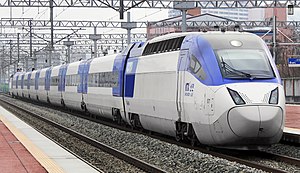KTX-II
| KTX-Sancheon | |
|---|---|

KTX-Sancheon class 110000
|
|
| Manufacturer | Hyundai Rotem |
| Family name | Hanvit |
| Constructed | 2008- |
| Entered service | 2010 |
| Number built |
71
|
| Number in service |
63
|
| Formation |
PC+8T+PC
|
| Capacity |
363 (Class 110000)
410 (SRT Class 120000)
|
| Operator(s) | Korail, SR |
| Depot(s) | Goyang, Osong |
| Line(s) served |
Gyeongbu High Speed Railway Honam High Speed Railway Suseo High Speed Railway (from 2016) Gyeongbu Line Honam Line Gyeongjeon Line Jeolla Line Donghae Line AREX Wonju - Gangneung Line (from 2017) Jungang Line (from 2017) |
| Specifications | |
| Car body construction |
traction heads: steel intermediate cars: aluminum |
| Train length | 201 m (659 ft) |
| Car length |
traction heads: 22,690 mm (74 ft 5.3 in) extreme intermediate cars: 21,845 mm (71 ft 8.0 in) intermediate cars: 18,700 mm (61 ft 4.2 in) |
| Width |
traction heads: 2,814 mm (110.8 in) intermediate cars: 2,970 mm (116.9 in) |
| Height |
traction heads: 4,062 mm (159.9 in) extreme intermediate cars: 4,100 mm (161.4 in) intermediate cars: 3,480 mm (137.0 in) |
| Floor height | 1,125 mm (44.3 in) |
| Maximum speed |
service: 305 km/h (190 mph) design: 330 km/h (205 mph) |
| Weight |
empty: 403 t (397 long tons; 444 short tons) loaded: 434 t (427 long tons; 478 short tons) |
| Traction system | 8 three-phase asynchronous induction motors 4 IGBT-based VVVF inverters |
| Power output | 8 x 1,100 kW (1,500 hp) (8.8 MW or 11,800 hp) |
| Acceleration | 0.45 m/s2 (1.5 ft/s2) up to 60 km/h (37 mph) 0 to 300 km/h (0 to 186 mph) in 316 s and 16.4 km (10.2 mi) |
| Deceleration | 1.06 m/s2 (3.5 ft/s2) (+5% -0% tolerance) from 300 to 0 km/h (186 to 0 mph) in 3.3 km (2.1 mi) |
| Auxiliaries | 2 x 1.0 MW (1,300 hp), supplying 670 V DC IGBT-based |
| Power supply | catenary |
| Electric system(s) | 25 kV/60 Hz AC |
| Current collection method |
pantograph (type: single-arm, SSS400+) |
| UIC classification | Bo'Bo' + 2'(2)(2)(2)(2)(2)(2)(2)2' + Bo'Bo' |
| Braking system(s) | eddy current, regenerative, rheostatic, disc |
| Safety system(s) | TVM 430 (ATC), ATP, ATS |
| Coupling system | Scharfenberg |
| Multiple working | Yes |
| Track gauge | 1,435 mm (4 ft 8 1⁄2 in) standard gauge |
71
63
PC+8T+PC
363 (Class 110000)
410 (SRT Class 120000)
(SRT Class 130000)
(Class 140000)
The KTX-Sancheon is a South Korean high-speed train built by Hyundai Rotem in the second half of the 2000s and operated by Korail since March 2009. With a top speed of 305 km/h (190 mph), the KTX-Sancheon is the second commercial high-speed train developed in South Korea.
When South Korea started its high-speed rail project, rolling stock and infrastructure was built in the framework of a technology transfer agreement between GEC-Alsthom (today Alstom), the main maker of French TGV high-speed trains, and South Korean companies. Thus Korea Train Express (KTX) began operating with KTX-I trains, which were derived from the TGV Réseau, and built both by Alstom and Rotem. The technology transfer agreement did not provide for a complete control of manufacturing processes, and construction involved the import of parts. To increase the domestic added value, in 1996, an alliance of South Korean government research agencies, universities, and private companies started a project called G7 to develop domestic high-speed rail technology.
The main element of the G7 project was the 7-car experimental high-speed train HSR-350x, originally intended as the prototype of a train with 20-car and 11-car versions for 350 km/h (217 mph) commercial service. The experimental train was used for trials from 2002, and achieved the South Korean rail speed record of 352.4 km/h (219.0 mph) on December 16, 2004.
Already before HSR-350x was finished, in 2001, a study focusing on the needs of the less frequented Honam Line proposed a modified, modular train that allows shorter configurations by removing traction equipment from the intermediate cars next to the traction heads, while reducing top speed to 300 km/h (186 mph). Possible configurations would have been 12-car, 10-car, and 8-car versions with two traction heads and 8-car, 6-car versions with one traction head and a driving trailer. The versions with two traction heads would have offered 500, 384 and 268 seats respectively. The active passenger compartment pressure control system of the HSR-350x wasn't deemed necessary for the proposed Honam high-speed train, only pressure isolation as in the KTX-I.
...
Wikipedia
